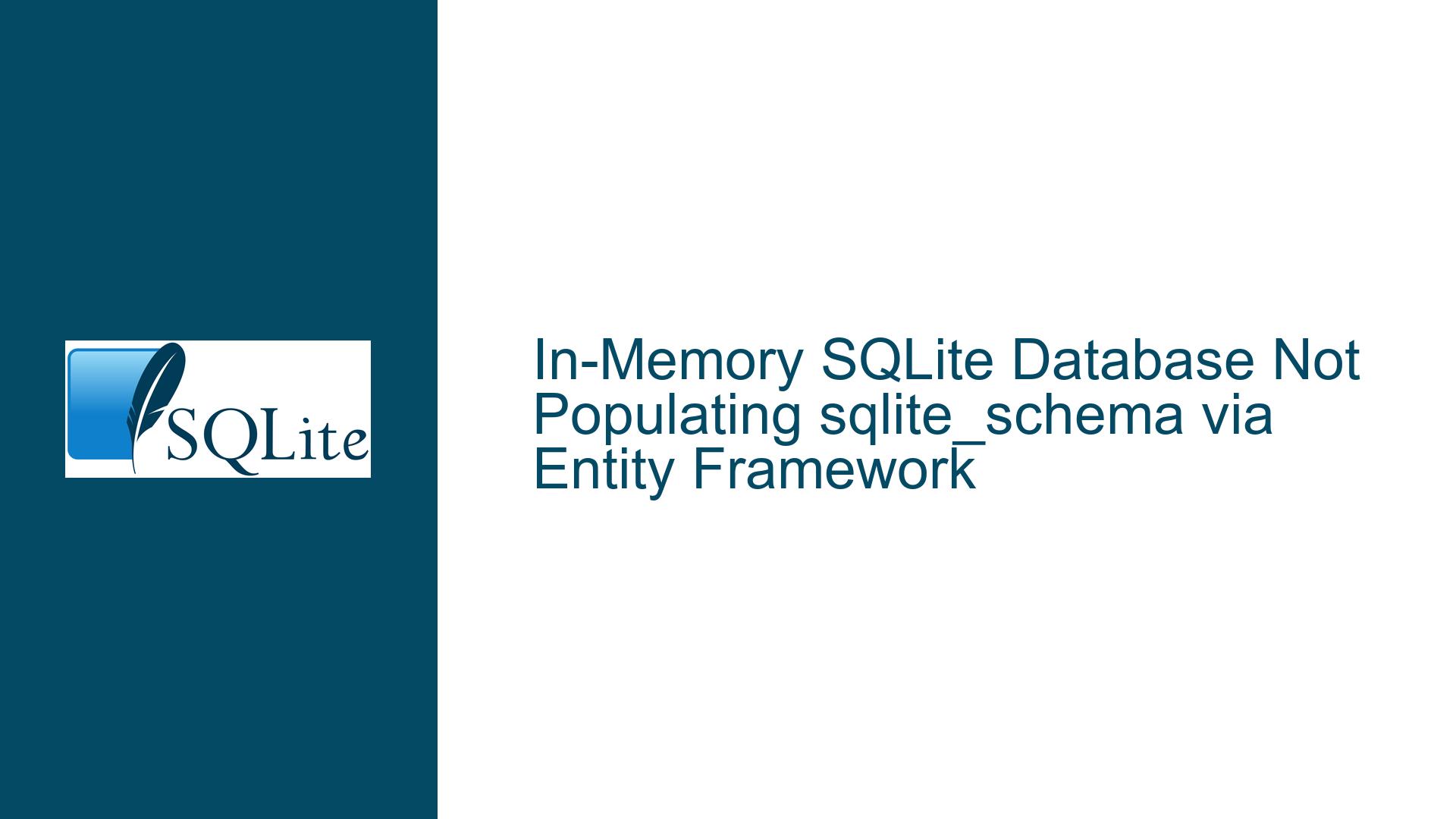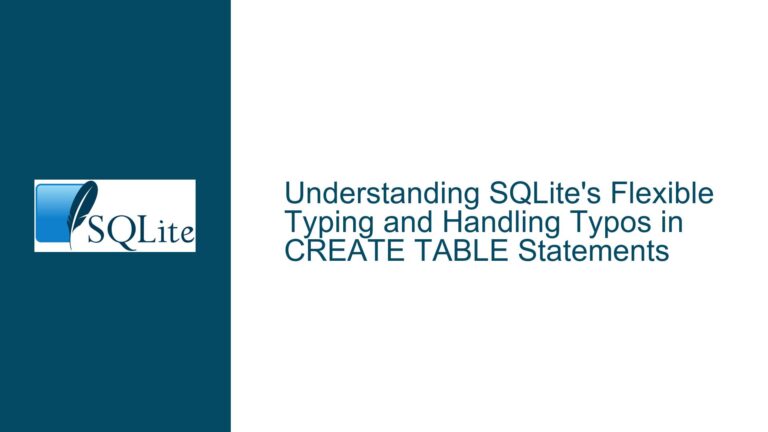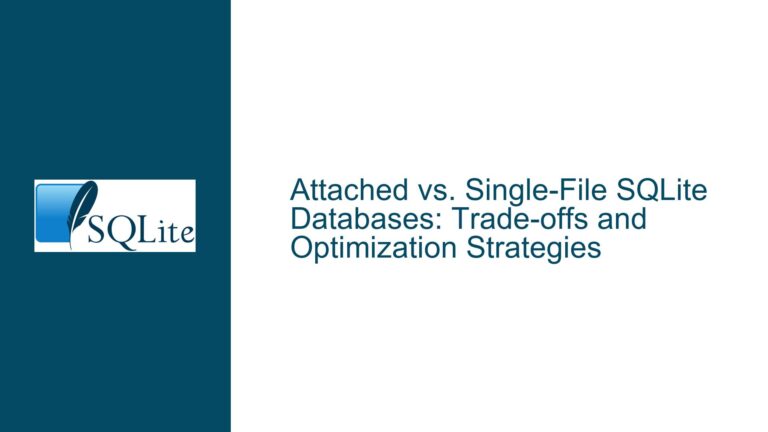In-Memory SQLite Database Not Populating sqlite_schema via Entity Framework
Understanding SQLite In-Memory Database Initialization and Schema Visibility
Issue Overview
The core challenge arises when using Entity Framework’s Code First approach with an SQLite in-memory database (Data Source=:memory:), where querying the sqlite_schema table returns no results despite successful table creation in a persisted (file-based) database. This discrepancy is rooted in the behavioral differences between transient in-memory databases and persisted databases, compounded by nuances in how Entity Framework (EF) manages connections, transactions, and schema initialization.
Key observations include:
- A fresh in-memory SQLite database starts empty, with no pre-existing schema entries.
- Schema changes (e.g., table creation) in an in-memory database are visible only within the same connection unless explicitly configured otherwise.
- EF’s default behaviors, such as automatic migration execution and connection lifecycle management, may differ significantly between file-based and in-memory databases.
Possible Causes of Missing Schema Entries in In-Memory Databases
Ephemeral Nature of In-Memory Databases
SQLite in-memory databases exist only for the duration of a single connection. Closing the connection destroys the database. If EF opens a connection, creates tables, and then closes the connection before queryingsqlite_schema, the database (and its schema) no longer exists. This contrasts with file-based databases, where schema persists across connections.Entity Framework Connection Handling
EF Core often opens and closes connections implicitly during operations likeDbContext.SaveChanges(). For in-memory databases, this can lead to premature disposal of the database. For example:- If EF creates tables during the first migration but closes the connection afterward, subsequent queries to
sqlite_schemawill target a new, empty in-memory database instead of the intended one.
- If EF creates tables during the first migration but closes the connection afterward, subsequent queries to
Lack of Explicit Migration Execution
EF may not execute migrations automatically for in-memory databases unless explicitly instructed. This is common when developers assume thatEnsureCreated()orMigrate()behaves identically across providers. If migrations are not applied, no tables exist to appear insqlite_schema.Cross-Connection Schema Visibility Limitations
By default, each:memory:connection creates a unique database. If EF initializes the schema on one connection and the application queriessqlite_schemaon another, the second connection sees an empty database. This is resolved only by using a shared cache (e.g.,Data Source=:memory:?cache=shared) or ensuring all operations use the same connection.Transaction Management
Schema changes in SQLite are visible only after transactions are committed. If EF creates tables within an uncommitted transaction,sqlite_schemaremains empty until the transaction is finalized. Misconfigured transaction scopes in EF can delay or prevent schema visibility.
Troubleshooting Steps, Solutions, and Fixes
1. Ensure Connection Persistence
Problem: EF closes the connection prematurely, destroying the in-memory database.
Solution: Manually open and retain the connection for the application’s lifetime.
Example (C#):
var connection = new SqliteConnection("Data Source=:memory:");
connection.Open();
var options = new DbContextOptionsBuilder<MyDbContext>()
.UseSqlite(connection)
.Options;
using (var context = new MyDbContext(options))
{
context.Database.EnsureCreated(); // Creates tables
// Perform operations and query sqlite_schema here
}
// Connection remains open, preserving the in-memory database
Verification:
- Query
sqlite_schemawithin the sameDbContextscope where tables are created. - Use
connection.Stateto confirm the connection remains open.
2. Enable Shared Cache for Cross-Connection Access
Problem: Multiple connections access separate in-memory databases.
Solution: Use a shared cache to allow connections to access the same in-memory database.
Modify the connection string:
Data Source=:memory:?cache=shared
Caveats:
- Shared cache requires SQLite 3.7.13+ and must be enabled at compile time (common in most distributions).
- All connections must include
cache=sharedin their connection strings.
3. Explicitly Execute Migrations
Problem: EF does not apply migrations automatically for in-memory databases.
Solution: Call EnsureCreated() or Migrate() during initialization.
using (var context = new MyDbContext(options))
{
context.Database.EnsureCreated(); // Creates tables immediately
// OR
context.Database.Migrate(); // Applies pending migrations
}
Debugging Tips:
- Check EF logs to confirm migrations are executed.
- Use
SELECT name FROM sqlite_schema WHERE type='table'in the same context to verify table creation.
4. Validate Transaction Commit Behavior
Problem: Uncommitted transactions hide schema changes.
Solution: Ensure transactions are committed before querying sqlite_schema.
Example:
using (var transaction = context.Database.BeginTransaction())
{
context.Database.ExecuteSqlRaw("CREATE TABLE Test (Id INTEGER PRIMARY KEY);");
transaction.Commit(); // Schema changes visible after commit
}
5. Cross-Check with SQLite CLI
Problem: EF-specific issues obscure SQLite’s inherent behavior.
Solution: Reproduce the scenario using SQLite’s command-line interface (CLI).
Steps:
- Start SQLite CLI with an in-memory database:
sqlite3 :memory: - Execute schema changes and queries:
CREATE TABLE Example (Id INTEGER); SELECT name FROM sqlite_schema WHERE type='table'; -- Returns 'Example'
Outcome: If tables appear in CLI but not in EF, the issue lies in EF configuration.
6. Inspect Entity Framework Provider Configuration
Problem: Using EF’s in-memory provider (not SQLite) for testing.
Solution: Ensure the correct provider (Microsoft.EntityFrameworkCore.Sqlite) is used.
Incorrect Configuration:
services.AddDbContext<MyDbContext>(options =>
options.UseInMemoryDatabase("TestDb")); // Uses non-SQLite in-memory provider
Correct Configuration:
services.AddDbContext<MyDbContext>(options =>
options.UseSqlite("Data Source=:memory:"));
7. Diagnose Connection String Parameters
Problem: Misconfigured connection strings prevent schema retention.
Solution: Include critical parameters like Mode=Memory and Cache=Shared.
Example:
Data Source=:memory:;Mode=Memory;Cache=Shared
Parameter Breakdown:
Mode=Memory: Explicitly enforces in-memory mode (redundant but clarifies intent).Cache=Shared: Enables cross-connection access (requires SQLite 3.7.13+).
8. Leverage EF Core Logging for Debugging
Problem: Silent failures during migration or table creation.
Solution: Enable EF Core logging to capture SQL statements and errors.
Example:
var options = new DbContextOptionsBuilder<MyDbContext>()
.UseSqlite("Data Source=:memory:")
.LogTo(Console.WriteLine, LogLevel.Debug)
.Options;
Analysis:
- Look for
CREATE TABLEstatements in logs. - Check for exceptions during migration execution.
9. Test with Hybrid Persistence
Problem: Isolating whether the issue is specific to in-memory databases.
Solution: Temporarily use a file-based database with Data Source=file::memory:?cache=shared.
Advantages:
- Behaves like an in-memory database but persists to a file for inspection.
- Allows examining the database schema using tools like DB Browser for SQLite.
10. Review SQLite and EF Core Versions
Problem: Incompatibilities between SQLite versions and EF Core.
Solution: Update to the latest SQLitePCLRaw bundle and EF Core packages.
Example (Package Manager Console):
Update-Package Microsoft.EntityFrameworkCore.Sqlite
Update-Package SQLitePCLRaw.bundle_e_sqlite3
By systematically addressing connection lifecycle management, migration execution, and SQLite’s in-memory idiosyncrasies, developers can ensure that sqlite_schema accurately reflects the database state in Entity Framework applications. The solutions above provide a comprehensive toolkit for resolving schema visibility issues, whether through code adjustments, configuration tweaks, or deeper diagnostic practices.






